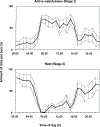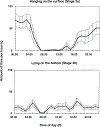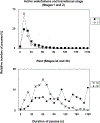Rest and activity states in a gray whale
- PMID: 11012865
- PMCID: PMC8788645
- DOI: 10.1046/j.1365-2869.2000.00212.x
Rest and activity states in a gray whale
Abstract
The behaviour of a female gray whale (Eschrichtius robustus) that had been rescued 14 months previously was recorded continuously on a video-recorder for 9 days at 'Sea World' in San Diego. On average, during the first six recording days, active wakefulness accounted for 37.9 +/- 1.7% of each 24 h; transitional stage for 17.4 +/- 1.4% and rest for 41.2 +/- 1.7%. In the rest stage the whale was lying on the bottom of the pool (13.2 +/- 1.7%) or hanging on the surface (28. 0 +/- 1.7%). During the rest stage, it was immobile most of the time and moved only for respiration. In the rest stage both eyes could be open, one eye could be open while the other was closed or, more rarely, both eyes could be closed. Characteristic jerks of the head, neck and sometimes of the whole body were observed in the whale during the rest stage. Most jerks were single and only 10% of all jerks were serial (occurring within 10 s of a prior jerk). Eyelid movements accompanied 40% of jerks. In two episodes, intense jerks followed each other continuously for 3 and 4 s and were accompanied by eyelid movements. These jerks resembled the twitches characteristic of paradoxical sleep in terrestrial mammals. During these episodes the whale was falling slowly onto its side and subsequently started to swim in the pool.
Figures






References
-
- Amlaner CJ and Ball NJ Avian sleep. In: Kryger MH, Roth T and Dement WC (Eds) Principles and Practice of Sleep Medicine. W.B. Saunders, Philadelphia, 1994: 81–94.
-
- Belkovich VM and Shchekotov MH The Beluga Whale. The Behavior and Bioacoustic in the Wild. Acoustic Institute of Russian Academy of Sciences, Moscow, 1990. (in Russian).
-
- Flanigan WF Nocturnal behavior of small Cetaceans. I. The bottlenose porpoise, Tursiops truncatus. Sleep Res, 1974a, 3: 84.
-
- Flanigan WF Nocturnal behavior of small Cetaceans. II. The beluga whale, Delphinapterus leucas. Sleep Res, 1974b, 3: 85.
-
- Flanigan WF More nocturnal observations of captive, small Cetaceans. I. The killer whale, Orcinus orca. Sleep Res, 1975a, 4: 139.
Publication types
MeSH terms
Grants and funding
LinkOut - more resources
Full Text Sources

